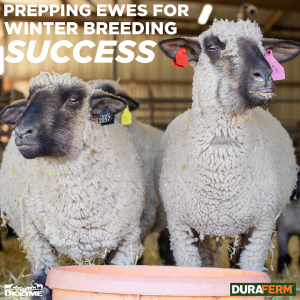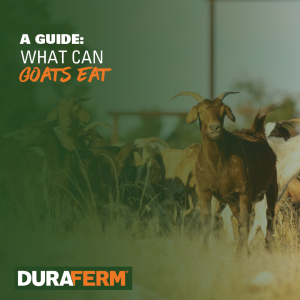
Summer heat has penetrated all parts of the country. For livestock and especially your flock, that means unwanted heat stress during this critical time of year. High temperatures combined with excessive humidity play a critical role in heat stress on your sheep, something that impacts growth, performance and reproduction.
Heat stress will affect the flock any time external temperatures reach 75 degrees and hotter for multiple consecutive days. However, as Susan Schoenian, University of Maryland Extension Sheep and Goat Specialist, points out every geographical region has its difference when heat stress sets in largely due to the humidity and the overall temperature heat index of the specific area. She also said that each breed has its own degree of heat resiliency. Hair sheep tend to be more resistant to heat and humidity, so breeds from a tropical climate like Katahdins, St. Croix and Barbados would be most heat tolerant. Dorpers are from a hot, dry climate, but still would be more resistant to heat than wool breeds. However, wool can help mitigate climate stress, during both hot and cold temperatures.
“Wool protects sheep from extreme heat as well as extreme cold. A thick fleece is mostly immune to temperature changes due to its insulating properties. According to research, sheep with a one-inch fleece are more comfortable than sheep with less wool, as wool fibers dissipate heat more rapidly,” Schoenian said. She reminds producers that spring shearing will allow for enough growth prior to summer to allow heat to escape the sheep’s body.
Signs of Heat Stress
As with any animal, some of the signs of heat stress include gathering up under shade or near a water source, decreased grazing time and going off feed. Other signs to look for are lack of overall energy, increased panting, drooling and increased respiratory rate.
It is common for sheep to shade up, especially if their water source is near the shade provided to them. You’ll likely see them out grazing early morning, but by mid-morning when the temperature rises, you’ll see them move to a large group under the shade, stop grazing and perhaps even start panting, when the combined heat and humidity makes it really hot.
Take Proactive Steps to Mitigate Heat Stress
You can plan accordingly with the prevention of heat stress with the assistance of weather forecasting devices, some simple shade and plenty of water. Shade can consist of natural shade like trees or manmade structures like barns or temporary structures. Be sure to provide shade in an area with good air circulation. If your shade is a hoop building or other enclosed structure be sure to provide good circulation. Use fans to circulate air, so the enclosed structure doesn’t add to the animals’ already elevated temperatures.
Avoid working or transporting sheep during the hottest time of the day. If you do need to work or haul sheep in the summer months, do so early in the morning or later in the evening to prevent unnecessary heat stress. Remember to look ahead to the long-range weather forecast to see if there is a cooler day approaching that might be more feasible for working conditions.
Schoenian suggests providing a mineral with loose salt and keeping your water source in the shade to encourage water consumption during the summer.
Impact on Reproductivity
Not only does heat impact the overall health of an animal, heat stress can be detrimental to the reproductive success of the flock. Schoenian said that both the ram and the ewe’s reproductive systems are at jeopardy during excessive heat.
“The production of sperm can be halted, making the ram temporarily sterile. Heat can also affect the ram’s libido. In addition, heat stress can also affect embryo survival and fetal development in ewe,” she said.
As many sheep producers are breeding their ewes in July, August and September, it is important to keep their overall and reproductive health top of mind. Rams, including any wooly scrotums, should be sheared six to seven weeks prior to breeding season. Ewes are typically sheared prior to the onset of hot temperatures. If pasture breeding during extreme heat, consider keeping rams in during the day and turning them out at night during the cooler temperatures.
Schoenian also suggests the use of a marking harness to monitor breeding activity in the summer months. If a ram is sterile, he will remark the ewes; if he lacks libido, he will not mark the ewes. This is assuming the ewes are cycling during the summer heat, which not all will, she adds.
Nutrition Factors In
Keeping your flock on a good nutritional plane will also help keep it healthy and performing. Schoenian recommends at minimum to offer a loose white salt, and depending on location, trace mineral salt. Selenium is typically needed. Check with your local nutritionist or sheep Extension specialist to see what other minerals are deficient in your area. She suggests a complete mineral mix with macro minerals like calcium and phosphorus to get the most nutritional needs covered.
The DuraFerm® line from BioZyme® offers ideal mineral options for your flock, especially at breeding time. DuraFerm Sheep Concept•Aid® provides balanced levels of high-quality vitamin and minerals required for growth, breeding and lambing. It contains organic zinc and manganese, selenium yeast and high levels of vitamin E to support maximum reproduction and health.
All DuraFerm products contain Amaferm®, a precision prebiotic designed to enhance digestibility by amplifying nutrient supply for maximum performance. It is research-proven to increase the energy available to the animal resulting in more milk production as well as the ability to initiate and maintain pregnancy and fertility. Simply, Amaferm increases intake, digestibility and absorption, getting the most nutrients from the feedstuffs provided.
In addition to DuraFerm Sheep Concept•Aid, a new product, DuraFerm Sheep Concept•Aid HEAT® was launched this spring. HEAT is a combination of plant extracts research-proven to lower body temperature, which can improve conception rates by maintaining pregnancy, and also includes garlic to deter insects. HEAT, combined with Amaferm, also research-proven to help maintain body temperature, should help your ewes get bred and stay bred, even through the hottest months of the year.
The final product in the DuraFerm line-up is the DuraFerm Sheep Concept•Aid Protein Tub. This cooked mineral tub includes organic trace minerals for more stability and 16% natural protein.
Treatment of Heat Stress
If your sheep do get overheated, and chances are they will at some point, be sure to give them immediate attention. It is vital to check on your livestock regularly during the summer heat, regardless of the proactive measures you’ve taken.
If you do find a sheep that shows signs of extreme heat exhaustion, get them to a shaded area with air movement. Make sure to get them hydrated by offering them clean, cold, fresh water. You might have to add electrolytes or force them to drink with a drench gun to ensure hydration. You can also rub cool water on the bare area between their hind legs, and this will help cool them down. You should, however, avoid pouring water on them because that wool acts like an insulator and they won’t get cooled off.
Summer heat is no fun, but neither are low conception and lambing rates. Keep your flock feeling its best with plenty of shade, ample fresh water and a nutrition program to help maintain body temperature and get your ewes bred.

